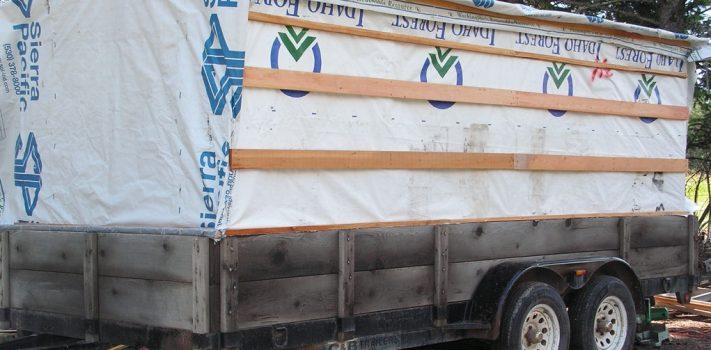This Bug Out Trailer (BOT) as it is presented here is intended to be a concept rather than a set of building plans. This is a low-cost structure that only requires only common tools and materials. The photos provided can say more than I could describe in a multi-part article.
The BOT can be a single-purpose utility or a multi-purpose platform that is lightweight and inexpensive to build. In essence, it is a modern version of the horse-drawn wagon trailers used beginning around the 1860’s that became the modern RV. It is an example, of what the Marine Corps advocates: That we should improvise, adapt, and overcome a problem in the best way we can with what we have, and where we are located. At its heart, it requires a can-do attitude that allows us to use our ingenuity.
During World War 2, the German high command was intimidated by the ability of American troops to create solutions in the field that allowed us to continue to fight even though the Nazis had destroyed our equipment. That is the kind of American we need to be today: tenacious, ingenious, and unstoppable.
Of course, this trailer would not be necessary if one could run out and buy a commercially made enclosed trailer. Fortunately, as I am a modern-day hillbilly of sorts, an old-fashioned American, this sort of thing comes naturally. I would have no problem toughing it out in Third World living conditions. Wherever my alternate retreat location might be, having food, tools, and shelter in hand, like our pioneer forefathers, I could carve out an existence even now, in my old age.
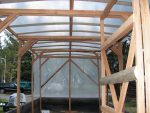
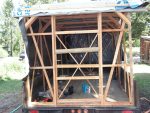 If I owned an alternative retreat location, then it would be best to deliver this trailer there now, offload the contents, and then return with the same trailer bed to use it once again to deliver, yet more supplies to the same or another alternative retreat location. This approach is cost-effective. I cannot afford to purchase multiple trailers of any kind, but I can easily build this in less than a week and then reuse the trailer. Of course, I do not recommend becoming a refugee. This is a way to avoid that outcome. This a method for establishing a survival location at an alternative retreat located relatively near one’s primary retreat location.
If I owned an alternative retreat location, then it would be best to deliver this trailer there now, offload the contents, and then return with the same trailer bed to use it once again to deliver, yet more supplies to the same or another alternative retreat location. This approach is cost-effective. I cannot afford to purchase multiple trailers of any kind, but I can easily build this in less than a week and then reuse the trailer. Of course, I do not recommend becoming a refugee. This is a way to avoid that outcome. This a method for establishing a survival location at an alternative retreat located relatively near one’s primary retreat location.
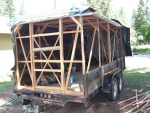
 The trailer bed is a car hauler with removable sides that measures approximately 7×16 feet. Each axle is rated for a maximum of 2,500 pounds, therefore the GVWR might be around 5,000 pounds if the tires are also rated for the weight. To avoid overloading it, I would load it with no more than 3,000 pounds of cargo. The heavier the structure built upon the bed, the less weight that can be the equipment and life-sustaining supplies carried inside.
The trailer bed is a car hauler with removable sides that measures approximately 7×16 feet. Each axle is rated for a maximum of 2,500 pounds, therefore the GVWR might be around 5,000 pounds if the tires are also rated for the weight. To avoid overloading it, I would load it with no more than 3,000 pounds of cargo. The heavier the structure built upon the bed, the less weight that can be the equipment and life-sustaining supplies carried inside.
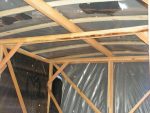
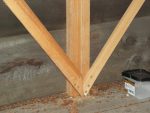 The idea here with a BOT is to use it to transport as many of the bare necessities as possible. The trailer should be used to transport food, tools, and shelter. Once at a location, the supplies can be off loaded and the shelter can be used on the trailer. Or it can be slid off of the back of the trailer by chaining it to a tree and sliding the trailer out from underneath the shelter. As pictured, I believe that four men could pick it up it up and walk it off the trailer. It is much lighter than it looks. A standard camping trailer could be used, however, since many more pounds life-sustaining supplies can be fit inside an enclosed trailer.
The idea here with a BOT is to use it to transport as many of the bare necessities as possible. The trailer should be used to transport food, tools, and shelter. Once at a location, the supplies can be off loaded and the shelter can be used on the trailer. Or it can be slid off of the back of the trailer by chaining it to a tree and sliding the trailer out from underneath the shelter. As pictured, I believe that four men could pick it up it up and walk it off the trailer. It is much lighter than it looks. A standard camping trailer could be used, however, since many more pounds life-sustaining supplies can be fit inside an enclosed trailer.
A converted camping trailer or enclosed utility trailer would be a more efficient means of transporting the supplies and tools which would keep us alive, and for a longer time, while we adapt to our new retreat. A larger used travel trailer that has a good roof, but an interior that has deteriorated could be gutted to the stud walls or remodeled with a chainsaw and used similarly. A trailer like this might be dirt cheap to purchase. Slap new tires on the wheels, add a wood stove, and it would be good to go. Of course, your current travel trailer that is in good condition could also be used as well.
Versatility is Key
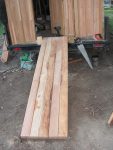
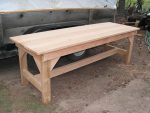 If one has a particular need, one might also imagine how this could be used in many different scenarios as well as their intended purpose. We are mostly limited by our imaginations. The table seen in the photos allows for heavy items to be loaded, yet can also be dining table or a platform to sleep on. Strive to think outside the box before building something like this and attempt to anticipate how it might be designed to be more versatile in the future for your purposes and situation.
If one has a particular need, one might also imagine how this could be used in many different scenarios as well as their intended purpose. We are mostly limited by our imaginations. The table seen in the photos allows for heavy items to be loaded, yet can also be dining table or a platform to sleep on. Strive to think outside the box before building something like this and attempt to anticipate how it might be designed to be more versatile in the future for your purposes and situation.
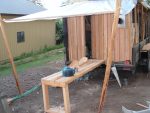
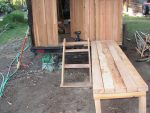 I built this to be a platform for many possible contingencies and therefore added the necessary accessories and features that make it as versatile as possible — given the low-cost, or no-cost materials that I had close at hand. The wood stove is an essential part of this as would also be a 55-gallon or 30-gallon drum to hold water. As a Bug Out Trailer, or a portable storage shed, shop, or cabin to be delivered to a location that could be used to store equipment and supplies at a primary, or secondary location, and as a temporary living quarters that would be sturdier than the tents that were used by American pioneers who settled and overwintered in the Northwest, it would be adequate. The structure could also be re-used as the frame for a greenhouse.
I built this to be a platform for many possible contingencies and therefore added the necessary accessories and features that make it as versatile as possible — given the low-cost, or no-cost materials that I had close at hand. The wood stove is an essential part of this as would also be a 55-gallon or 30-gallon drum to hold water. As a Bug Out Trailer, or a portable storage shed, shop, or cabin to be delivered to a location that could be used to store equipment and supplies at a primary, or secondary location, and as a temporary living quarters that would be sturdier than the tents that were used by American pioneers who settled and overwintered in the Northwest, it would be adequate. The structure could also be re-used as the frame for a greenhouse.
A multi-purpose item is more valuable and we can further improve its potential value before or during its construction, and add accessories that increase its utility so that it may be used in different roles. Assessing the overall potential of the project could also motivate us to build it another way other than as it is presented here. Better materials certainly can be used as this example is the lowest cost method. Over time the structure could be improved with the use of thin plywood on the roof and sides, and/or by using tar paper and metal roofing as time and money become available.
A Professional Scrounger
Because I have many competing priorities and an extremely limited budget, I will likely have to make do with this build, and do the best that I can with what I have. As a self-proclaimed professional scrounger, I am confident that I will eventually be able to source additional materials and better materials to improve the roof. Improving the roof would be the most valuable upgrade to the structure, as you can see in the photos.
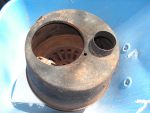
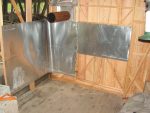 If other materials had been available at no cost, then I would have used them, yet it would not be as light in weight as it is. The total cash-out-of-pocket cost of this project was about $80 in Torx head screws, $40 for a dark green tarp, and $15 for the aluminum sheeting used to protect the walls from a hot wood stove. At a minimum, I would use commercial 2″ x 2″ x 8′ foot lumber. I already had the wood stove. It was only $100 as a surplus item.
If other materials had been available at no cost, then I would have used them, yet it would not be as light in weight as it is. The total cash-out-of-pocket cost of this project was about $80 in Torx head screws, $40 for a dark green tarp, and $15 for the aluminum sheeting used to protect the walls from a hot wood stove. At a minimum, I would use commercial 2″ x 2″ x 8′ foot lumber. I already had the wood stove. It was only $100 as a surplus item.
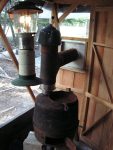
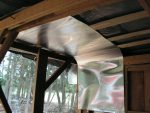 The rusty-looking stove pipe was free to me. It only looks bad, but it is still sound. The stove is ideal for this trailer. It is a M1941 tent stove. This is a WW2-era U.S. military stove that was also used in Korea. It is more than adequate as a heater and a cook stove. And it weighs less than 60 pounds. These are durable stoves made from virgin U.S. steel. Sadly, this kind of stove is no longer in production. Everything else I had on hand or obtained at a low cost, or no cost.
The rusty-looking stove pipe was free to me. It only looks bad, but it is still sound. The stove is ideal for this trailer. It is a M1941 tent stove. This is a WW2-era U.S. military stove that was also used in Korea. It is more than adequate as a heater and a cook stove. And it weighs less than 60 pounds. These are durable stoves made from virgin U.S. steel. Sadly, this kind of stove is no longer in production. Everything else I had on hand or obtained at a low cost, or no cost.
A Free Source of Lumber
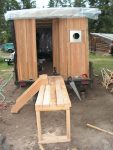
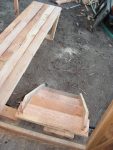 It was fortuitous that a friend of mine owns a lumber mill. So I was able to source dimensional lumber that was nonconforming or irregular, and otherwise unsuitable for his customers. Yet it is still high-grade fir and larch, better than the construction grade sold at most lumber yards. Using a limited supply of material required extra effort to engineer and construct the frame with the lumber that was at hand. For example, to provide the necessary strength needed in the roof and to construct a lightweight structure, several lengths of lumber were laminated or combined in such a way to create a roof capable of handling a snow load typical of northwest Montana winters.
It was fortuitous that a friend of mine owns a lumber mill. So I was able to source dimensional lumber that was nonconforming or irregular, and otherwise unsuitable for his customers. Yet it is still high-grade fir and larch, better than the construction grade sold at most lumber yards. Using a limited supply of material required extra effort to engineer and construct the frame with the lumber that was at hand. For example, to provide the necessary strength needed in the roof and to construct a lightweight structure, several lengths of lumber were laminated or combined in such a way to create a roof capable of handling a snow load typical of northwest Montana winters.
Ribs on the roof were arched using lumber that was thin enough to be bent. Yet, because of the arch in the roof structure, they are not so thin or narrow that the roof cannot withstand a snow load. If the material that you have available is on the flimsy side, then use additional ribs or better, sheets of 3/8″ plywood that can be shaped into an arch. That would greatly increase the snow load capacity and eliminate the need for the arched roof rafters, if the plywood itself acted in place of the rafters, when arched. The design of the roof structure has roots in lightweight aircraft construction or RV construction. If several layers of polymer sheeting were stretched and held in place, then they would contribute to the strength of the roof.
If In Doubt, Then Build It Stout
At a cost of only $28 each for the four sheets of 3/8 plywood needed to greatly strengthen the roof, I will eventually do this once or if funds become available. Alternatively, I could build a superstructure over it at the destination. An A-frame roof made of pine poles and bows could be an expedient improvement. Most builders can make a better example than what I’ve presented here if they can afford to do so. This an extremely low-cost build that I would not recommend unless one has little money to use and is a person who understands how to build lightweight yet strong structures.
If you do not have experience with this sort of design, then I would advise using heavier lumber and over-engineering the structure to be as strong as possible. Plywood siding would greatly improve the shear strength and better hold it upright. But in my humble opinion, the structure shown in the photos is adequately strong and as light as can be reasonably made with the minimal funds expended. The lighter the structure the more food and equipment can be hauled. As the builder, you will decide what compromises must be made.

